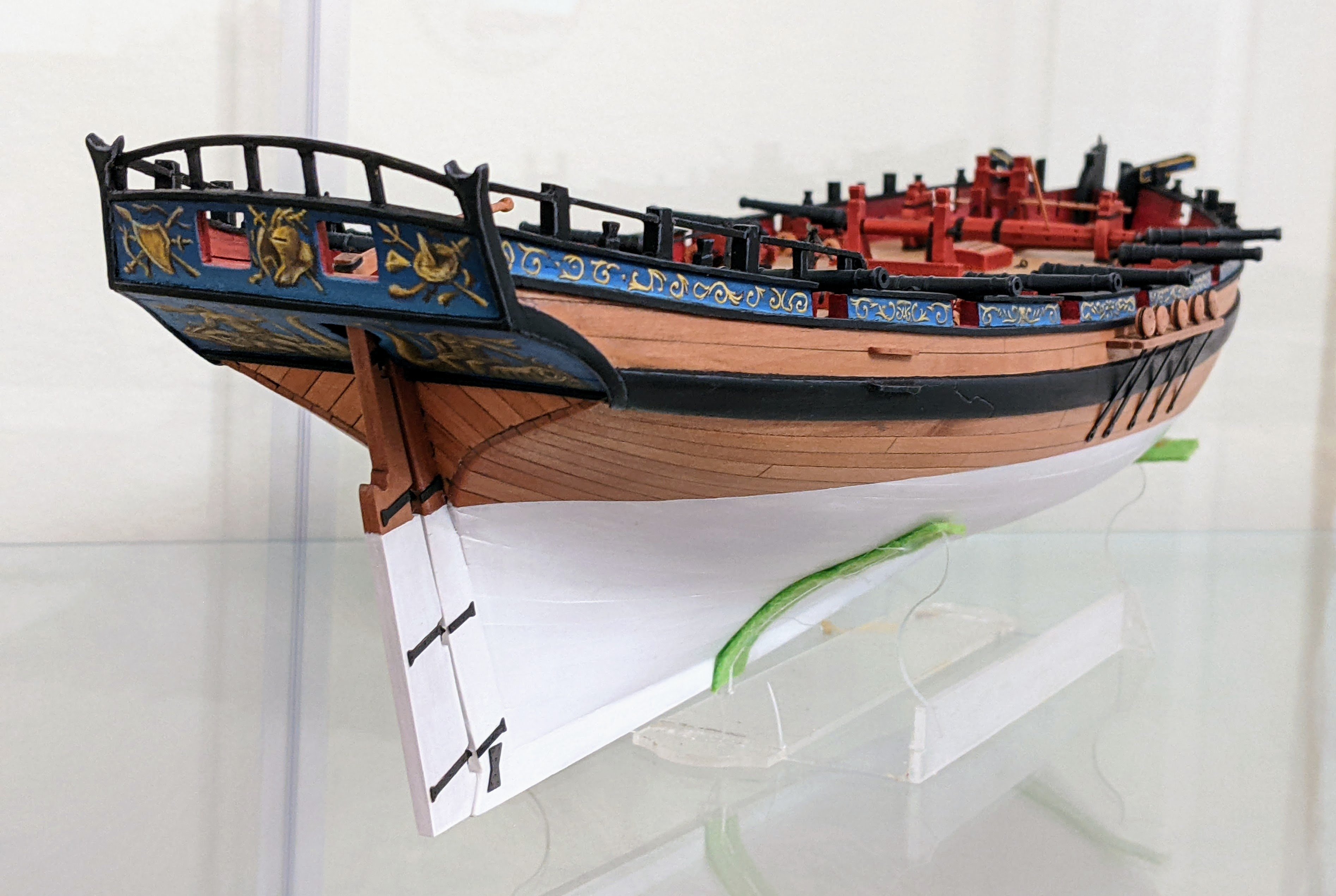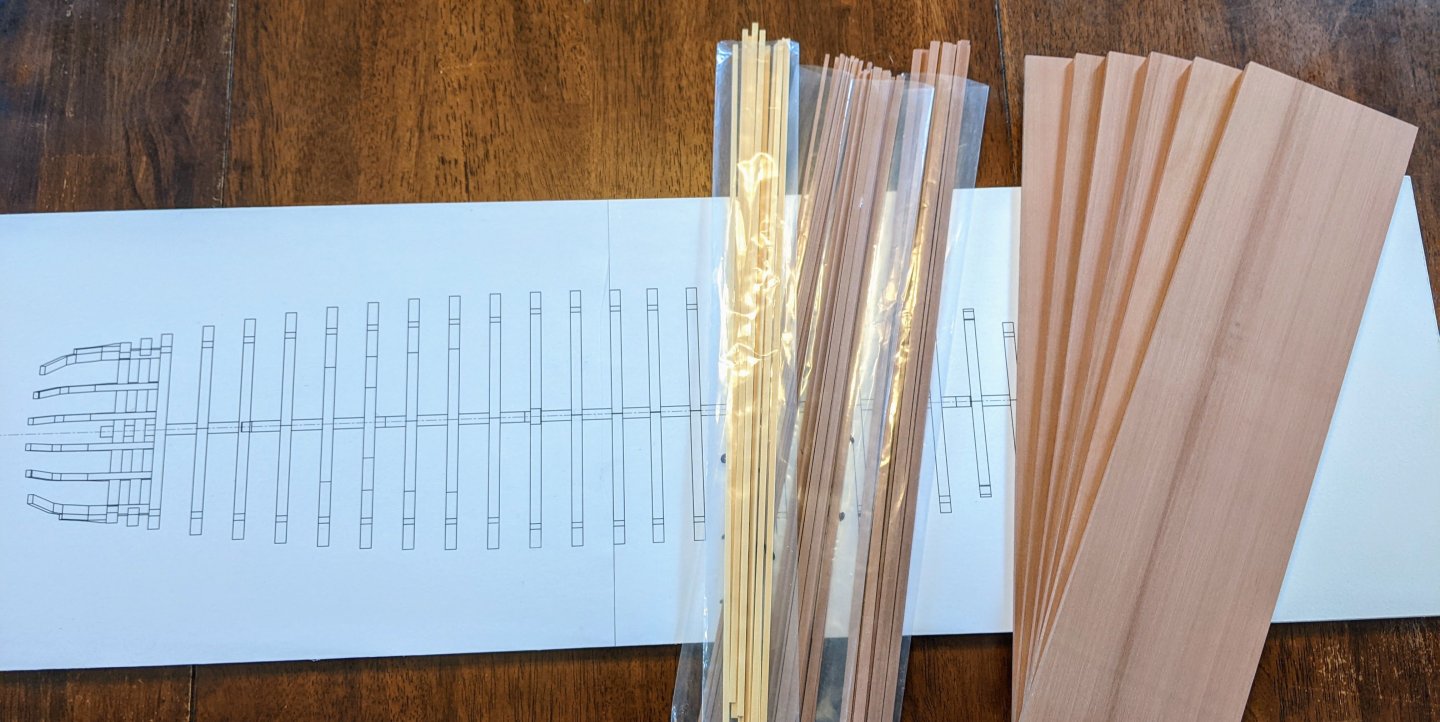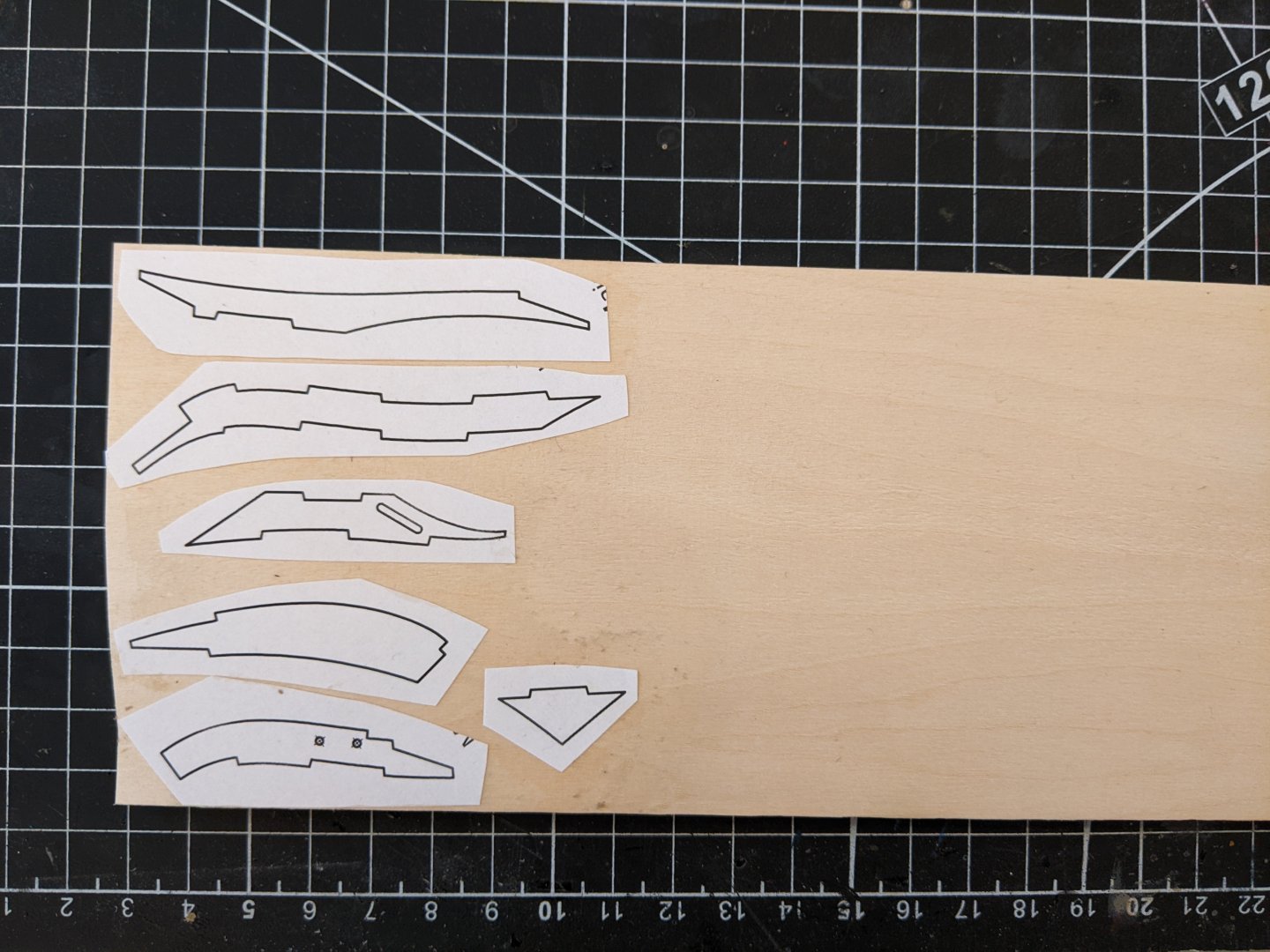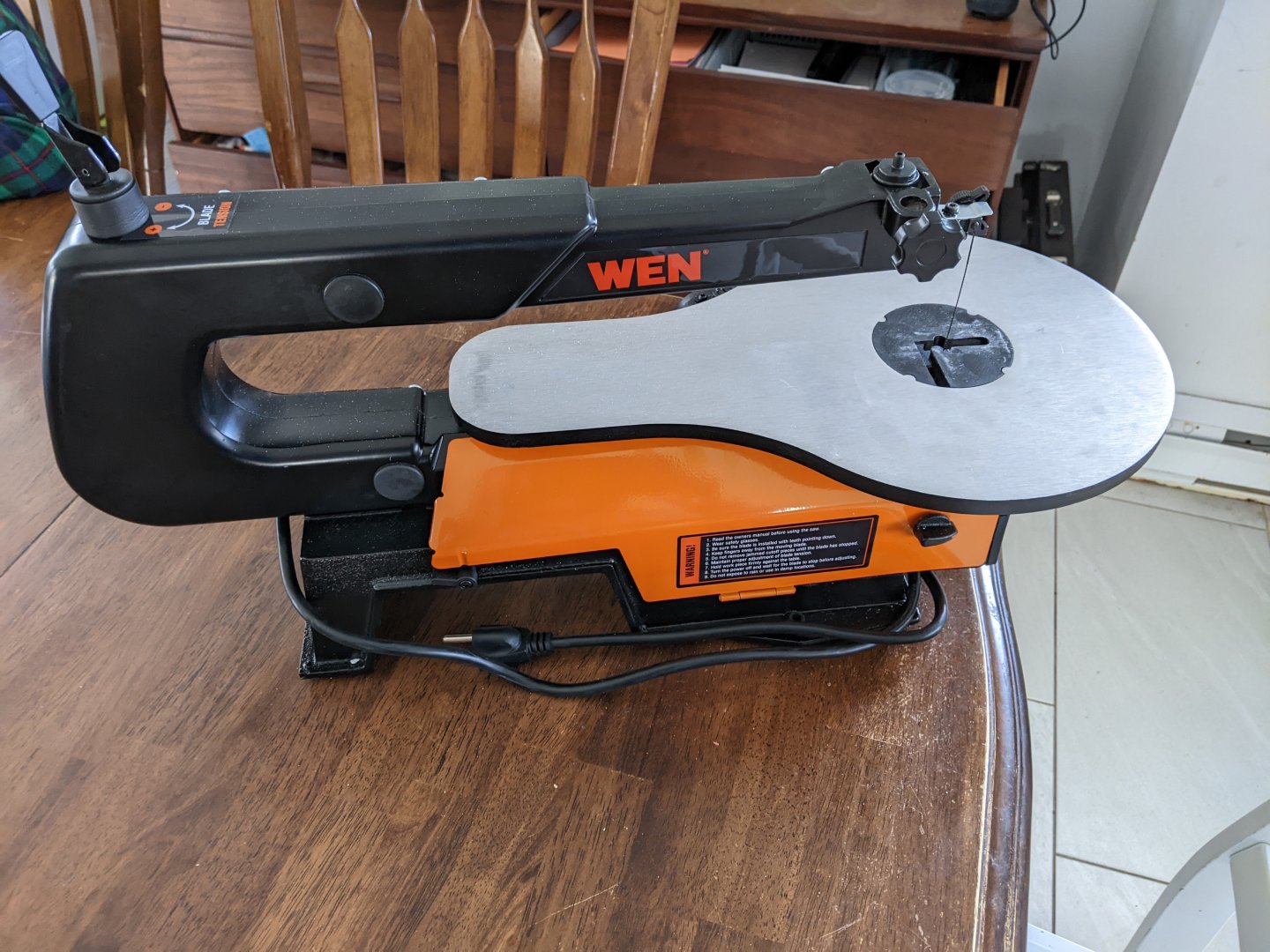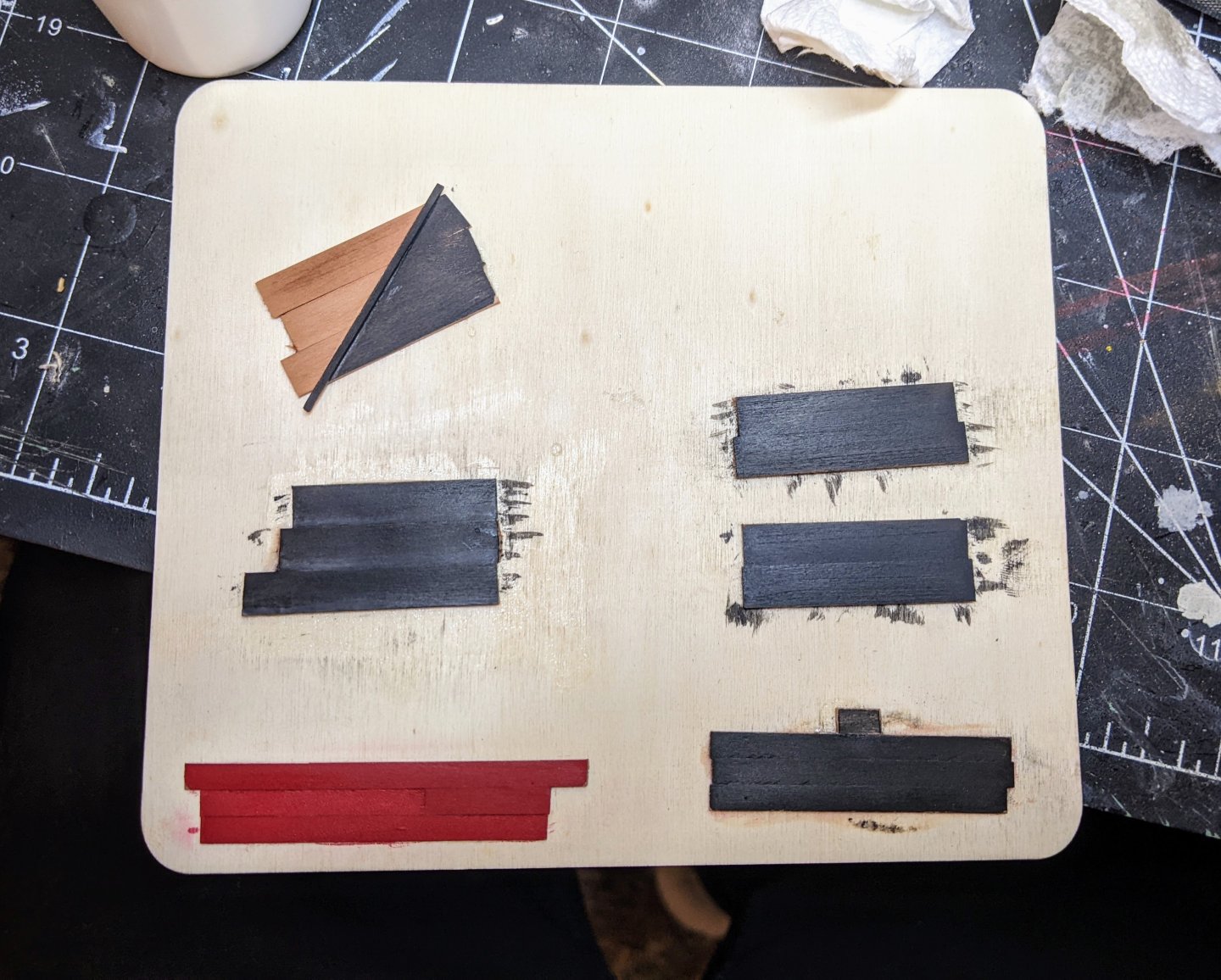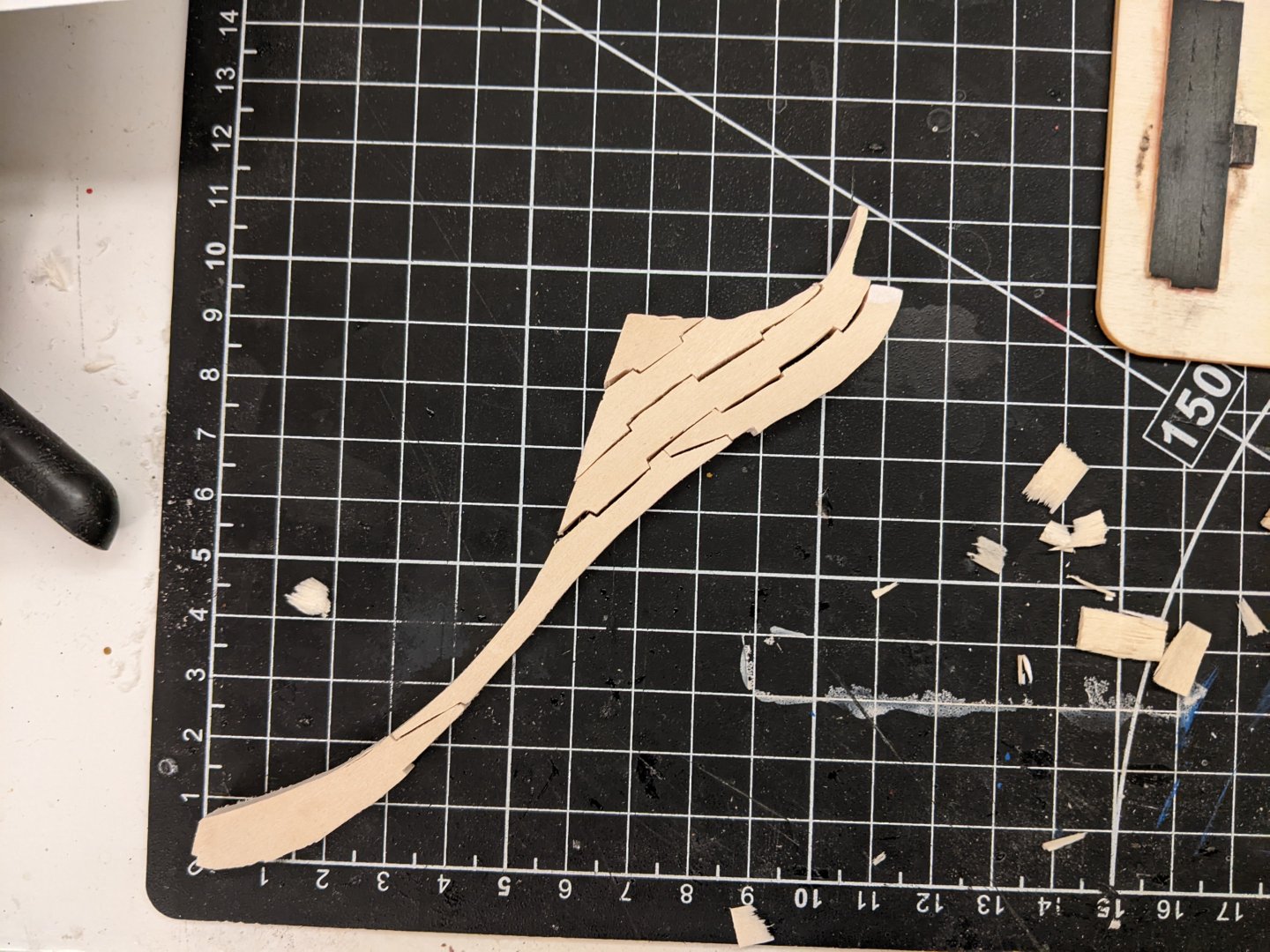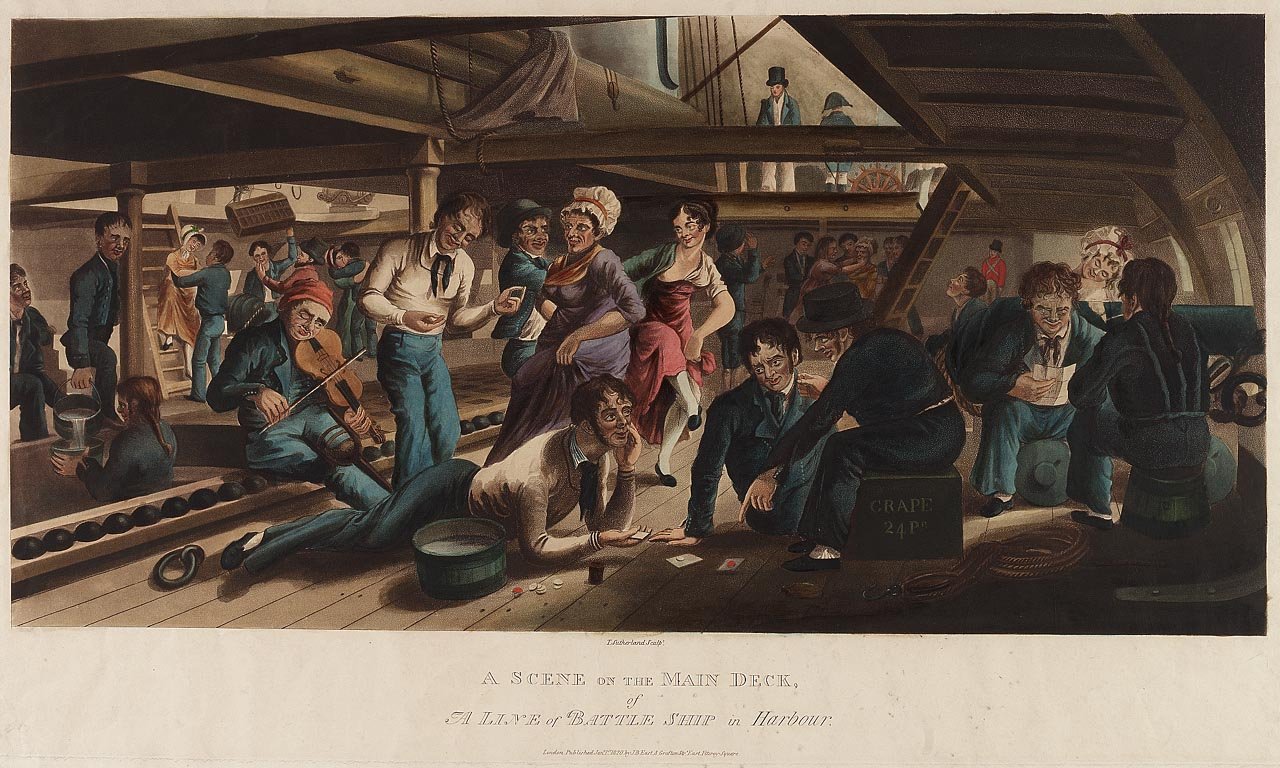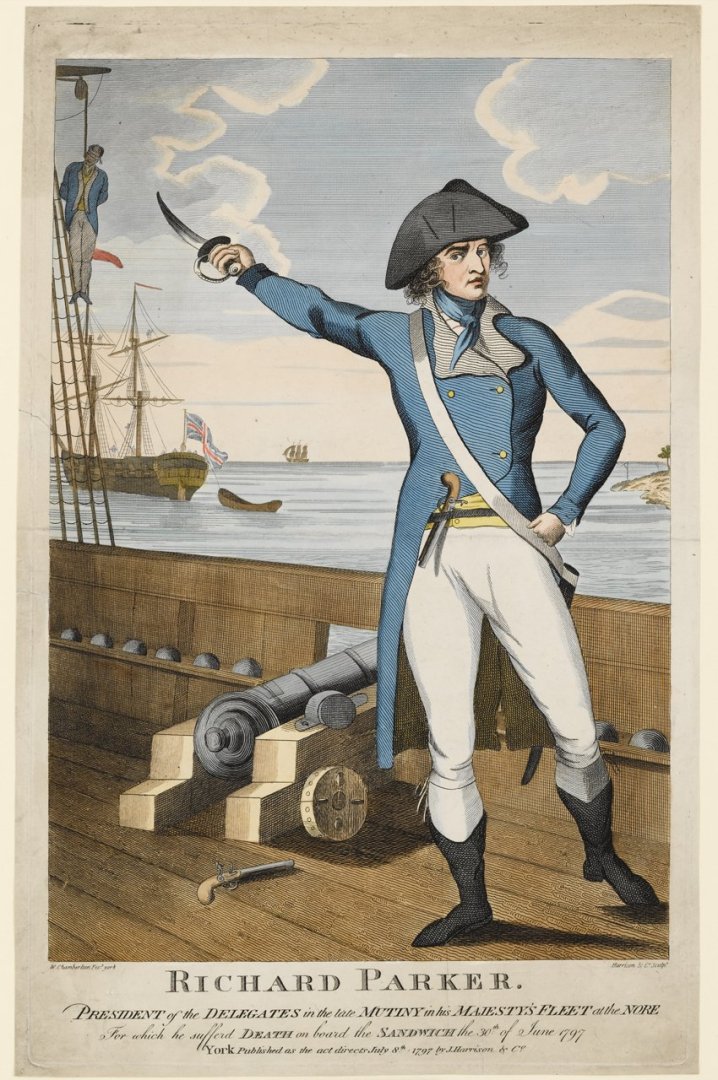-
Posts
1,324 -
Joined
-
Last visited
Content Type
Profiles
Forums
Gallery
Events
Everything posted by Thukydides
-

Linus Napoleonic shipyard
Thukydides replied to Linus Spjutsberg's topic in New member Introductions
Welcome aboard. These are some very cool models. -
Looking good. I used a similar method rigging as I went up. Your decision to do as much of the rigging off model as you can is very wise. One thing you might want to consider is how much the lower yards will get in the way when you are doing the upper shrouds. You might want to put the topmasts in place before putting the yards on. Where the ratlines for the shrouds are really fiddly, you may risk catching the yards. Just a thought.
- 114 replies
-
- Vanguard Models
- Speedy
-
(and 1 more)
Tagged with:
-

Bit of a problem! HMS Speedy, Vanguard Models
Thukydides replied to JohnEvans's topic in Masting, rigging and sails
I am with Alan on this one. I think you should just remake it. Also as you said it is better to not add things that stick out until you are completely ready for them. I like to only put the lower masts in, then rig them, then proceed to the topmasts, then rig them etc... -
Great job Rob, you should be proud of her.
- 47 replies
-
- Erycina
- Vanguard Models
-
(and 1 more)
Tagged with:
-
Welcome to MSW. Good luck on your dory.
-
Well done, she is a lovely model.
- 201 replies
-
- Oyster Sharpie
- first scratch build
-
(and 1 more)
Tagged with:
-

USS Constitution by mtbediz - 1:76
Thukydides replied to mtbediz's topic in - Build logs for subjects built 1751 - 1800
Fantastic work Mustafa. She is really coming together now. -
Good luck, I will be following along. I assume you got this info from Winfield. I am not sure I trust him on this one in any case it is certainly missing some info. The Sphinx class were ordered to be modified to include 8 12-pdr carronades in 1779, but the actual implementation was a bit more varied. The earliest Ariadne could have been given them is 1780, but at the very least Ariadne was equipped with 8 carronades in 1782 as she appears on the Middleton list (see the appendix of my Perseus draft document). She also appears on a 1793 list (which is much smaller as many ships had gotten rid of carronades) showing her still with the 8 12-pdr carronades (again see the appendix). In 1797 there is was a request to replace 4 of the carronades with 4-pdr long guns though it is not clear from the catalog description (I don't have the actual document) if this meant going down to 2 carronades or 4. You could probably make an argument for either and it might be worth your while getting the original document as it shouldn't cost that much (being likely only a few pages). In any case the rating change to a 24 gun ship likely didn't occur till 1797. Edit: if you are getting your info from threedecks.org, I am in the process of revising many of the Sphinx class there so you may see some changes as I get round to making edits. This is actually the survey done before Sphinx's breakup. Though it likely reflects what many of the ships looked like late in their careers. Earlier they tended to only have the quarterdeck built up while the forecastle was left as it originally was. This was true of Perseus at least up until 1790 and may very well have been true of Ariadne. On the question of the figurehead, there is a lines plan for Ariadne, just not digitized. If you have the money it might be worth ordering a digital copy from the RMG as it may very well have the figurehead and decorations on it. If it was me I would give it a shot. https://www.rmg.co.uk/collections/objects/rmgc-object-83731 If you have any specific questions I am happy to share some of my research with you. I have a lot more done behind the scenes, it is just not yet fully complete and ready for release.
-
Thanks to everyone for all the suggestions. I have been watching lots of youtube videos and am going to keep practicing. I keep cranking up the tension a little higher and havn’t broken a blade yet. My biggest problem at the moment is going with the grain. I will be cutting along the line fine and then all of a sudden it starts to wander. Yes I have read / heard this a bunch. Like many things practically what this means is harder to get down. I am also still struggling with sometimes when I turn the piece I end up deflecting the blade to the side and don’t realize till when I let go the blade snaps back into the correct position. I suspect like many things this will just require practice. It is less of a problem since I tightened the blade more so maybe even more tension is needed? Just what sort of ping is required is difficult to get down. I use a combination of liquitex and daler rowney inks as that is what I have on hand. I may consider others, but as I am planning to start playing with shades and hues a bit and I already have all the colours I need. I may look into the markers, but in general I prefer the control I have with the liquid ink as I can thin it down (particularly important with the black). I have not tried dye though I have considered it. The worry I have with it is one of control. I have seen you previously mention Frieberg’s leather dye, but as a bunch of my painting is probably going to have to be done. on model, I would be worried about making a mistake. I am going to keep playing with the acrylic ink first to see if I can achieve the effect I want. If not I may consider other options, but at this point I am relatively optimistic that the ink will work. I have gotten some aspects of the finish I want and I think it is mostly just a matter of practice and getting the ratios right. Some inks (particularly the black) need to be thinned down quite a bit to keep them translucent enough to allow my underpainting to show through.
-
Log #14: Practice Makes Perfect It has been a while since I posted an update mostly because I don’t have much concrete to show. On the research side I have been continuing my work on identifying contemporary paintings / drawings showing the details of pre-bloomfield guns. I have also been working hard at updating and correcting the document and I hope to release a second version with a number of new sections and transcribed primary sources in the coming months. On the modelling side I received a scroll saw for Christmas and have been practicing with it on some cheap 1/4 in basswood I got at my local hardware store. Like anything it is much harder to use than it looks and I want to make sure that I really know what I am doing before I try cutting anything important. Getting the tension right seems to be one of the tricky parts. If anyone has any helpful tips on getting precise cuts I am all ears. Speaking of wood Canada Post finally came through the other day and I received my wood order from @Joe V. This is only the wood for the keel / stem / sternpost / stern framing which will be made of pear. I haven't yet fully nailed down how much and what sizes I will need for the planking etc… I also got some yellow cedar strips as I am considering using it on certain parts of the model. I will need to do some tests to decide exactly how I am going to proceed. You can also see in this photo the beginnings of the build board with the top view of the model glued to it. Finally, I have been doing a number of tests using scrap wood left over from my alert build on painting options. I have been experimenting with the effects I can get with relatively translucent inks. You can see some of my early test below. A lot more tests will need to be done before I am willing to commit to a path, but I think at this point I have an idea of the aesthetic I want to go for. Part of the uncertainty relates to one of the current focuses of my research, did the coppering on Perseus come up to the wales or only the waterline. No clear answers yet, but if anyone has any contemporary sources which talk about the very early coppering that was done by the RN (1775-1780ish) I would love to hear about it. Edit: I made a first attempt at the knee of the head and it doesn't look that great but practice makes perfect. I think next time I am going to try cutting further from the lines and sanding / filing / using my mini chisels to get a better fit.
-
Well done, that is a fine looking model.
- 32 replies
-
- Grand Banks Dory
- Model Shipways
-
(and 2 more)
Tagged with:
-
Yes a capstan and a windlass perform the same function. Smaller vessels such as cutters tended to have windlasses and larger two or three masted vessels had capstans. However, I am not actually sure why this was the case. I assume in the case of larger vessels the double capstan allowed them to generate more power, but why a brig used a capstan and a cutter a windlass I am not sure.
-
To be fair I have a 1794 primary sources which seems to indicate that 12pdrs and up had a double single combo for the tackle blocks. I have also identified a 1765 list which show at least 18pdr and up had the double single combo, but I don't have access to the sections of it showing the smaller calibers and so it is on my list to acquire at some point. I suspect given the similarities it has to the 1794 list that it also will show12pdrs and up had the single double combo. On the how it is secured, that was why I was wondering about the source. The resolution is not very good, but if you squint it looks like there might be something round the breeching (maybe a thimble?). I have been trying to identify a primary source depiction of the "double thimble" method of attaching the breeching to the cascabel which was prevalent from 1760s till the 1800s. That being said a number of other aspects of the image are questionable and likely it is just someone without a lot of knowledge blindly copying elements from things they have seen before. But I always like to see if I can identify the original source when I see something unusual as occasionally it has some basis in truth.
-
They would have been stored in shot garlands. There are lots of examples that you can find in build logs of ships all over the forums. Many of them would have been stored below deck, but some would have been kept close at had for loading. There are three basic types of shot garlands that you will find: First those on racks on the bulwarks (see the below contemporary drawing example from 1797): https://www.rmg.co.uk/collections/objects/rmgc-object-145388 Second those around the hatches. I have seen some examples of these where there appears to be a lip under them such as the below one from 1820: https://www.rmg.co.uk/collections/objects/rmgc-object-147286 Finally I have read about movable shot garlands. These could be carried around, but I have never seen any contemporary images of them. If anyone has seen any I would love to see an example.
-
Isopropyl will loosen PVA and acetone will loosen CA. Be careful as you don't want to get it on any finished parts as it may stain them. It doesn't really matter which side you choose to tapper, just pick one side and stick with it. Theoretically you could just cut the correct curved shape out of sheet stock, but using strips you need to do a combination of edge bending and tapering to get them to fit right. You should be able to just place the plank in the right place without any effort if you have done it right. I do planks individually, but do one on one side then one on the other. The reason is to make sure that the plank ends at the bow and stern are lining up with each other. You should check out the planking tutorial videos (look under modelling techniques in the top bar). Also take a look at some of the build logs for people who have done similar ships. As @vossiewulf said starting a build log is a good idea. Good luck.
-
Beautiful work as always Tom. So many cool little details which combine together to create a really impressive model. Personally my eyes are drawn to the shields. I like how the bright colours contrast with the drab wooden ship. Congrats!!!
-

USS Constitution by mtbediz - 1:76
Thukydides replied to mtbediz's topic in - Build logs for subjects built 1751 - 1800
I like the dark grey better. You could also look into dry brushing with a slightly lighter colour on the top to give a bit more contrast. Looking good. -
One thing I also found with the fly tying thread is you have to give it some extra twist as you serve it on otherwise it lies too flat. Yes magnification is the way to go when doing the smaller threads. The yard looks very nice
- 714 replies
-
- lady nelson
- victory models
-
(and 1 more)
Tagged with:
-

Painting question
Thukydides replied to jcurtis55's topic in Painting, finishing and weathering products and techniques
One further thought on this. You can actually use the fact that the grain raises to your advantage. One of the issues with making scale models look realistic is that in real life nothing is just one colour. There are minor variations which our eyes pick up on even if we don't consciously notice them. In miniature painting one of the things you are trying to do to make something look realistic is trick the eyes into thinking it is bigger than it is. I have been experimenting lately with very thin ink coats to raise the grain, sand it back and then go in with a slightly different shade, sand it back etc... This produces subtle variation on the colour which I have found to produce an interesting effect. Obviously you need very watered down coats for this to work, but it is also something you could experiment with on scrap wood. As a note I would say whatever you do try it out on some scrap first to make sure you are happy with it before you try on the model. -
Welcome to MSW.
-
Welcome to MSW
-
Welcome to MSW. I also came from the plastic modeling world and started with a cutter. I think they are good starter ships if you have some modeling experience as they allow you to work through all the many problems that come from switching from plastic to wood without overwhelming you. There are a number of cutter model kits out there you could consider, most of them on the lower end of the price scale for wooden models. Take a look at some build logs and find one that inspires you. Maybe read up on the history of the ship a bit. If you are interested in your subject you are far more likely to complete it. Good luck.
About us
Modelshipworld - Advancing Ship Modeling through Research
SSL Secured
Your security is important for us so this Website is SSL-Secured
NRG Mailing Address
Nautical Research Guild
237 South Lincoln Street
Westmont IL, 60559-1917
Model Ship World ® and the MSW logo are Registered Trademarks, and belong to the Nautical Research Guild (United States Patent and Trademark Office: No. 6,929,264 & No. 6,929,274, registered Dec. 20, 2022)
Helpful Links
About the NRG
If you enjoy building ship models that are historically accurate as well as beautiful, then The Nautical Research Guild (NRG) is just right for you.
The Guild is a non-profit educational organization whose mission is to “Advance Ship Modeling Through Research”. We provide support to our members in their efforts to raise the quality of their model ships.
The Nautical Research Guild has published our world-renowned quarterly magazine, The Nautical Research Journal, since 1955. The pages of the Journal are full of articles by accomplished ship modelers who show you how they create those exquisite details on their models, and by maritime historians who show you the correct details to build. The Journal is available in both print and digital editions. Go to the NRG web site (www.thenrg.org) to download a complimentary digital copy of the Journal. The NRG also publishes plan sets, books and compilations of back issues of the Journal and the former Ships in Scale and Model Ship Builder magazines.

